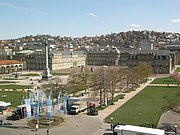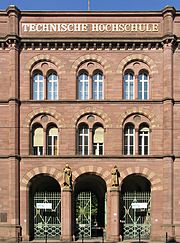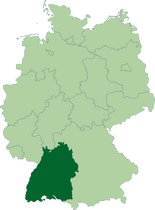| Main | Births etc |
|---|
| Baden-Württemberg | |||
|---|---|---|---|
| — State of Germany — | |||
|
|||
| Coordinates: | |||
| Country | Germany | ||
| Capital | Stuttgart | ||
| Government | |||
| • Minister-President | Winfried Kretschmann (Green) | ||
| • Governing parties | Greens |
||
| • Votes in Bundesrat | 6 (of 69) | ||
| Area | |||
| • Total | 35,751.65 km2 (13,803.79 sq mi) | ||
| Population (2010-12-31)[1] | |||
| • Total | 10,753,880 | ||
| • Density | 300/km2 (780/sq mi) | ||
| Time zone | CET (UTC+1) | ||
| • Summer (DST) | CEST (UTC+2) | ||
| ISO 3166 code | DE-BW | ||
| GDP/ Nominal | € 376.28 billion (2011) [2] | ||
| NUTS Region | DE1 | ||
| Website | www.baden-wuerttemberg.de | ||

A campaign sticker, translated, "We can [do] anything. Except [speak] Standard German." This is an allusion to the Baden-Württemberg being one of the principal centres for innovation in Germany and has many inhabitants with distinctive dialects.
Baden-Württemberg is one of the 16 states of Germany. Baden-Württemberg is in the southwestern part of the country to the east of the Upper Rhine, and is the third largest in both area and population of Germany's sixteen states, with an area of 35,742 square kilometres (13,800 sq mi) and 10.7 million inhabitants.[3] The state capital is Stuttgart.
The sobriquet Ländle ("small land" in the local dialect) is sometimes used as a synonym for the Swabian part of Baden-Württemberg.
History[]
The area used to be covered by the historical states of Baden, including the former Prussian Hohenzollern, and Württemberg, part of the region of Swabia.[4]
Württemberg was occupied by the Romans in the first century AD who defended their position there by constructing a limes (fortified boundary zone). Early on in the third century, the Alemanni drove the Romans beyond the Rhine and the Danube, but in their turn they succumbed to the Franks under Clovis I, the decisive battle taking place in 496. It later became part of the Holy Roman Empire.
After World War II, Allied forces established three federal states: Württemberg-Hohenzollern, Baden (both occupied by France), and Württemberg-Baden (US-occupied). In 1949, these three states became founding members of the Federal Republic of Germany. Article 118 of the new German constitution, however, had already prepared a procedure for those states to merge. After a referendum held on 16 December 1951, Württemberg-Baden, Württemberg-Hohenzollern and Baden voted in favour of a merger.[3] Baden-Württemberg officially became a state on 25 April 1952.[3]
Geography[]
Baden-Württemberg shares its borders with France, Switzerland, Rhineland Palatinate, Hesse and Bavaria.[3]
Most of the major cities of Baden-Württemberg straddle the banks of the Neckar River, which runs downstream (from southwest to the centre, then northwest) through the state first past Tübingen, then Stuttgart, Heilbronn, Heidelberg, and Mannheim).
The Rhine (German: Rhein) forms the western border as well as large portions of the southern border. The Black Forest (Schwarzwald), the main mountain range of the state, rises east of the Rhine valley. The high plateau of the Swabian Alb, between the Neckar, the Black Forest and the Danube, is an important European watershed. Baden-Württemberg shares Lake Constance (Bodensee; the border with Switzerland is the middle of the lake) with Switzerland and it shares the foothills of the Alps (known as the Allgäu) with Bavaria and the Austrian Vorarlberg (but Baden-Württemberg does not border Austria over land).
The Danube (Donau) river has its source in Baden-Württemberg near the town of Donaueschingen, in a place called Furtwangen in the Black Forest.
Government[]
Administration[]








Baden-Württemberg is divided into 35 districts (Landkreise) and 9 independent cities (Stadtkreise), both grouped into the four Administrative Districts (Regierungsbezirke) of Freiburg, Karlsruhe, Stuttgart, and Tübingen.
Furthermore there are nine independent cities, which do not belong to any district:
A. Baden-Baden
B. Freiburg
C. Heidelberg
D. Heilbronn
E. Karlsruhe
F. Mannheim
G. Pforzheim
H. Stuttgart
I. Ulm
Politics[]
The state parliament of Baden-Württemberg is the Landtag (Eng. state assembly).
The politics of Baden-Württemberg have traditionally been dominated by the conservative Christian Democratic Union of Germany (CDU), who until 2011 had led all but one government since the establishment of the state in 1952. In the Landtag elections held on 27 March 2011 voters replaced the Christian Democrats and centre-right Free Democrats coalition by a Greens-led alliance with the Social Democrats which secured a four seat majority in the state parliament.
From 1992 to 2001, the anti-immigration Republicans party had seats in the Landtag.[5]
Further supreme institutions of the state[]
The Baden-Württemberg General Auditing Office acts as an independent body to monitor the correct use of public funds by public offices.[6]
Economy[]
Although Baden-Württemberg has relatively few natural resources compared to other regions of Germany,[3] the state is among the most prosperous states[4] and is one of the wealthiest regions in Europe with a traditionally low unemployment rate. A number of well-known enterprises are headquartered in the state, for example Daimler AG, Porsche, Robert Bosch GmbH (automobile industry), Carl Zeiss AG (optics), and SAP AG (largest software enterprise in Europe). In spite of this, Baden-Württemberg's economy is dominated by small and medium-sized enterprises. Although poor in workable natural resources (formerly lead, zinc, iron, silver, copper and salts) and still rural in many areas, the region is heavily industrialized. In 2003, there were almost 8,800 manufacturing enterprises with more than 20 employees, but only 384 with more than 500. The latter category accounts for 43% of the 1.2 million persons employed in industry. The Mittelstand or mid-sized company is the backbone of the Baden-Württemberg economy.[7] Medium-sized businesses and a tradition of branching out into different industrial sectors have ensured specialization over a wide range. A fifth of the "old" Federal Republic's industrial gross value added is generated by Baden-Württemberg. Turnover for manufacturing in 2003 exceeded 240,000 million, 43% of which came from exports. The region depends to some extent on global economic developments, though the great adaptability of the region's economy has generally helped it through crises. Half of the employees in the manufacturing industry are in mechanical and electrical engineering and automobile construction. This is also where the largest enterprises are to be found. The importance of the precision mechanics industry also extends beyond the region's borders, as does that of the optical, clock making, toy, metallurgy and electronics industries. The textile industry, which formerly dominated much of the region, has now all but disappeared from Baden-Württemberg. Research and development (R&D) is funded jointly by the State and industry. In 2001, more than a fifth of the 100,000 or so persons working in R&D in Germany were located in Baden-Württemberg, most of them in the Stuttgart area.[8] Baden-Württemberg is also one of the Four Motors for Europe.
A study performed in 2007 by the pr campaign "Initiative for New Social Market Economy" (German: Initiative Neue Soziale Marktwirtschaft (INSM)) and the trade newspaper "Wirtschaftswoche" awarded Baden-Württemberg for being the "economically most successful and most dynamic state" among the 16 states.
Tourism[]
Baden-Württemberg is a popular holiday destination. Main sights include the capital and biggest city, Stuttgart, modern and historic at the same time, with its urban architecture and atmosphere (and famously, its inner city parks and historic Wilhelma zoo), its castles (such as Castle Solitude), its (car and art) museums as well as a rich cultural programme (theatre, opera) and mineral spring baths in Stuttgart-Bad Cannstatt (also the site of a Roman Castra); it is the only major city in Germany with vineyards in an urban territory.
The residential (court) towns of Ludwigsburg and Karlsruhe, the spas and casino of luxurious Baden-Baden, the medieval architecture of Ulm (Ulm Münster is the tallest church in the world), the vibrant, young, but traditional university towns of Heidelberg and Tübingen with their old castles looking out above the river Neckar, are popular smaller towns. Sites of former monasteries such as the ones on Reichenau Island and at Maulbronn (both World Heritage Sites) as well as Bebenhausen Abbey are to be found. Baden-Württemberg also boasts rich old Free Imperial Cities such as Biberach, Esslingen am Neckar, Heilbronn, Ravensburg, Reutlingen and Schwäbisch Hall, as well as the southernmost and sunniest city of Germany, Freiburg, close to Alsace and Switzerland, being an ideal base for exploring the heights of the nearby Black Forest (e.g. for skiing in winter or for hiking in summer) with its traditional villages and the surrounding wine country of the Rhine Valley of South Baden.[4]
The countryside of the lush Upper Neckar valley (where Rottweil is famous for its carnival (Fastnacht)) and the pristine Danube valley Swabian Alb (with Hohenzollern Castle), as well as the largely pristine Swabian Forest, the Rhine Valley and Lake Constance (German: Bodensee), where all kinds of water sports are popular, with the former Imperial, today border town of Konstanz (where the Council of Constance took place), the Neolithic and Bronze Age village at Unteruhldingen, the flower island of Mainau, and the hometown of the Zeppelin, Friedrichshafen a.o., are especially popular for outdoor activities in the summer months.[4]
In spring and autumn (April/May and September/October), beer festivals (fun fairs) are taking place at the Cannstatter Wasen in Stuttgart; the one in the autumn, the Cannstatter Volksfest, is the second biggest such festival in the world after the Munich Oktoberfest. In late November/early December, Christmas markets are a tourist magnet in all major towns, with the biggest one in Stuttgart, lasting for the three weeks prior to Christmas.
The Bertha Benz Memorial Route is a 194 km signposted scenic route from Mannheim via Heidelberg and Wiesloch to Pforzheim and back, which follows the route of the world's first long-distance journey by automobile which Bertha Benz undertook in August 1888.
Companies owned by Baden-Württemberg[]
| Company | Industry | Percentage owned | Source |
|---|---|---|---|
| EnBW | Energy industry | 45% | [9] |
| Badische Staatsbrauerei Rothaus | Beverage industry | 100% |
Education[]

University of Karlsruhe, since 2009: Karlsruhe Institute of Technology
Baden-Württemberg is home to some of the oldest, most renowned and prestigious universities in Germany, such as the universities of Heidelberg, Freiburg and Tübingen. It also contains four of the nine German 'excellence universities' (Heidelberg, Freiburg, Karlsruhe, and Konstanz).
Other university towns are Mannheim and Ulm. Furthermore, two universities are located in the state capital Stuttgart, the University of Hohenheim and the University of Stuttgart. Ludwigsburg is home to the renowned national film school Filmakademie Baden-Württemberg (Film Academy Baden-Wuerttemberg). The private International University in Germany is situated in Bruchsal. Perhaps one of the best private universities in Germany sits here, located in Friedrichshafen, Zeppelin University.
Furthermore, there are more than a dozen Fachhochschulen, i.e. universities of applied sciences, as well as Pädagogische Hochschulen, i.e. teacher training colleges, and other institutions of tertiary education in Baden-Württemberg (a.o. in Aalen, Biberach an der Riss, Esslingen, Karlsruhe, Ludwigsburg, Nürtingen, Pforzheim, Ravensburg-Weingarten, Reutlingen, several in Stuttgart, Schwäbisch Hall).
The state has the highest density of academic institutions of any territorial state (i.e. excluding Berlin and Hamburg) in Germany.
Dialects[]
Two dialect groups of German are spoken in Baden-Württemberg in various variants: Alemannic and Franconian dialects. In central and southern Württemberg, the Alemannic dialect of Swabian is spoken (slightly differing even within the area, e.g. between Upper Swabia, the Swabian Alb and the central Neckar Valley of the Stuttgart region). In South Baden, the local dialects are Low Alemannic and High Alemannic (i.e. variants of what is also Swiss German). In the northern part of Baden, i.e. the former Kurpfalz (Electorate of the Palatinate) with the former capitals of Heidelberg and Mannheim, the idiom is Rhine Franconian (i.e. Palatinate German), while in the Northeast East Franconian is spoken.
The same or similar Alemannic dialects are also spoken in the neighbouring regions, especially in Bavarian Swabia, Alsace (Alsatian), German-speaking Switzerland (Swiss German) and the Austrian Vorarlberg, while the other Franconian dialects range from the Netherlands over the Rhineland, Lorraine and Hesse up to northern Bavaria Franconia.
Demographics[]
The population of Baden-Württemberg is 10,749,755 (2008), of which 5,466,966 are female and 5,282,789 are male, total population up 0.10 per cent over a year earlier. This was due to more births than deaths. In 2006, the birth rate was 8.61 per 1000, lower than that of 8.80 per 1000 in 2005. The death rate decreased from 8.80 per 1000 in 2005 to 8.60 per 1000 in 2006. In 2008, nearly 14.87 percent of the population under the age of 15, fell from 15.13 per cent over a previous year. The proportion of people aged 65 and over rose from 18.72 per cent to 18.99 per cent. Correspondingly, the median age (aged 15–64) of the population fell from 66.15 to 66.14 over the same period. The ratio of people aged under 15 and aged 65 and over to the population of working age (aged 15–64), the overall dependency ratio is 512 per 1000 in 2008. The sex ratio of total population is 0.966 male(s)/female.
Religion[]
While Northern and most of central Württemberg has been traditionally Lutheran–Protestant (later also Pietist) since the Reformation that was adopted there in 1534 (with its center at the famous Tübinger Stift) and the former Electorate of the Palatinate (Northwestern Baden) with its capital Heidelberg was shaped by Calvinism before being integrated into Baden, Upper Swabia, the Upper Neckar Valley up to the bishop seat of Rottenburg and Southern Baden (the Catholic archbishop has its seat in Freiburg) have traditionally been bastions of Catholicism.
| Religion | % | |
|---|---|---|
| Roman Catholics | 36.9%[10] | 4.0M |
| Evangelical Church in Germany | 33.3%[11] | 3.6M |
| Muslims | 5.6% | 600 000 |
| Buddhists | 0.23% | 25 000 |
| Hindu | 0.14% | 15 000 |
| Jews | 0.08% | 9 000 |
| Non Religious | 22.3% | 2.4M |
See also[]
- Baden, for the pre-19th century state
- History of Baden
- Württemberg and History of Württemberg
- Minister-President of Baden-Württemberg
- Origin of the coats of arms of German federal states
- Grand Duchy of Baden, for the state that existed from 1808–1918
- Republic of Baden, for the state that existed from 1918–1945
- Rulers of Baden, for a list of sovereigns and presidents
- historical “Wappen” (coat of arms)
- List of places in Baden-Württemberg
- Four Motors of Europe
- Staatsoper Stuttgart (part of “Staatstheater”)
- The Baden State Theatre at Karlsruhe
Footnotes[]
- ^ "Bevölkerung und Erwerbstätigkeit" (in German). Statistisches Landesamt Baden-Württemberg. 31 December 2009. http://www.statistik-bw.de/Veroeffentl/Statistische_Berichte/3126_10001.pdf.
- ^ "GDP of state". Portal of the Baden-Württemberg Statistics Office. http://www.statistik-bw.de/VolkswPreise/Landesdaten/LRtBWSjewPreise.asp. Retrieved 31 July 2012.
- ^ a b c d e "Our State". Baden-Württemberg. http://www.baden-wuerttemberg.de/en/Our_State/86236.html. Retrieved 30 March 2011.
- ^ a b c d Andrea Schulte-Peevers; Anthony Haywood, Sarah Johnstone, Jeremy Gray, Daniel (2007). Germany. Lonely Planet. ISBN 978-1-74059-988-7. http://books.google.com/books?id=Z5t5mZE_s5YC&pg=PA392#PPA391,M1. Retrieved 1 February 2009.
- ^ The Republikaner(REP): 15 from 146 MPs in 1992 and 14 from 155 MPs in 1996. "Baden-Württemberg. Results of the election from 1964–2011.". Statistisches Landesamt Baden-Württemberg. http://www.statistik.baden-wuerttemberg.de/Wahlen/Landesdaten/Landtagswahlen/LRLtWsitzvert.asp.
- ^ "Government and organs of state". Baden-Württemberg. http://www.baden-wuerttemberg.de/en/Government_and_organs_of_state/86233.html. Retrieved 30 March 2011.
- ^ Cooke, p. 84
- ^ "BADEN – WÜRTTEMBERG – Economy". Eurostat. June 2004. http://circa.europa.eu/irc/dsis/regportraits/info/data/en/de1_eco.htm. Retrieved 16 January 2009.
- ^ Haase, Nina (30 March 2011). "Business leaders wary of Greens' state election victory". Deutsche Welle. http://www.dw-world.de/dw/article/0,,14951861,00.html. Retrieved 30 March 2011.
- ^ chiesa cattolica http://www.dbk.de/imperia/md/content/kirchlichestatistik/bev-kath-l__nd-2008.pdf
- ^ EKD http://www.ekd.de/download/kirchenmitglieder_2007.pdf
References[]
- Philip Cooke, Kevin Morgan (1998). The Associational Economy: Firms, Regions, and Innovation. Oxford University Press. p. 84. ISBN 978-0-19-829659-1.
- Climate change in Baden-Württemberg: facts – impacts – perspectives / LUBW; Baden-Württemberg, Ministerium für Umwelt, Naturschutz und Verkehr. [In collab. with Karlsruhe Institute of Technology (KIT), Institute for Meteorology and Climate Research; Süddeutsches Klimabüro. Transl.: InTra eG Fachübersetzergenossenschaft], Stuttgart: Baden-Württemberg Ministry of the Environment, Nature Conservation and Transport Karlsruhe: LUBW, 2010.
External links[]
- Official website
- Baden-Württemberg at the Open Directory Project
 Geographic data related to Baden-Württemberg at OpenStreetMap
Geographic data related to Baden-Württemberg at OpenStreetMap
| |||||||||||||
| |||||||||||
| This page uses content from the English language Wikipedia. The original content was at Baden-Württemberg. The list of authors can be seen in the page history. As with this Familypedia wiki, the content of Wikipedia is available under the Creative Commons License. |





